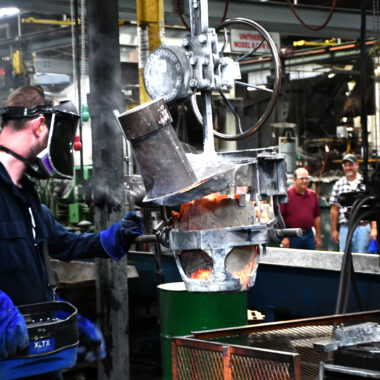Mastering About Aluminum Casting: Techniques Demystified
Mastering About Aluminum Casting: Techniques Demystified
Blog Article
Crafting Perfection: How to Accomplish High-Quality Light Weight Aluminum Castings Whenever
In the realm of light weight aluminum spreading, the pursuit of excellence is a continuous trip that requires a precise method and a keen understanding of the ins and outs entailed. Attaining constant high-quality aluminum spreadings requires a detailed grasp of the processes, from choosing the ideal alloy to carrying out exact mold styles and diligently regulating casting criteria.
Understanding Aluminum Casting Processes
Light weight aluminum casting procedures, important in the manufacturing sector, involve the elaborate improvement of liquified light weight aluminum into solid types with a collection of thoroughly regulated actions. Comprehending these processes is vital to accomplishing top notch aluminum castings regularly - about aluminum casting. The main approaches made use of in light weight aluminum casting are die spreading, sand spreading, and investment casting

Each of these processes has its advantages and is chosen based on elements like complexity, volume, and preferred finish of the light weight aluminum spreading. about aluminum casting. Understanding the intricacies of these methods is critical for manufacturers intending to produce top notch light weight aluminum spreadings consistently
Picking the Right Light Weight Aluminum Alloy
Choosing the suitable aluminum alloy is a crucial choice in the production of top quality aluminum spreadings. The option of alloy considerably impacts the residential or commercial properties and qualities of the final item. Different light weight aluminum alloys provide varying degrees of stamina, deterioration resistance, machinability, and thermal conductivity. When choosing a light weight aluminum alloy for spreading, it is essential to consider the specific demands of the application to make sure optimal efficiency.
One of the most frequently utilized light weight aluminum alloys for casting is A356 - about aluminum casting. For applications calling for high toughness, 7075 light weight aluminum alloy is a preferred selection due to its exceptional strength-to-weight ratio.
Along with mechanical homes, factors to consider such as price, availability, and post-casting procedures need to likewise influence the choice of the best aluminum alloy. By carefully assessing these elements, manufacturers can guarantee the manufacturing of top quality aluminum castings that fulfill the wanted requirements.
Applying Correct Mold Layout
Developing an effective mold and mildew style is important for making sure the successful production of high-quality light weight aluminum spreadings. Proper mold layout plays a substantial duty in attaining the wanted characteristics of the end product. To implement an effective mold style, factors such as product flow, cooling down prices, and part geometry need to be carefully taken into consideration.
One trick element of mold layout is guaranteeing correct filling and solidification of the aluminum within the mold cavity. This includes designing jogger and gating systems that promote smooth metal circulation and prevent issues such as air entrapment see it here or incomplete dental filling. Additionally, integrating cooling channels right into the mold design assists regulate solidification rates and lower the danger of porosity or shrinkage flaws.

Controlling Casting Parameters

Making Certain Post-Casting High Quality Checks
To maintain the top quality of aluminum spreadings, complete post-casting quality checks are essential. After the spreading process is finished, it is crucial to make sure that the final products fulfill the preferred criteria and specs. One of the main quality checks includes evaluating the surface coating of the spreadings to recognize any kind of problems such as porosity, splits, or surface abnormalities. This aesthetic inspection is commonly supplemented by non-destructive testing approaches like ultrasonic testing or dye penetrant examination to spot interior problems that may compromise the honesty of the casting.
Dimensional precision is one more important facet that must be confirmed throughout post-casting top quality checks. Dimensions of vital measurements and resistances need to be taken to confirm that the spreadings conform to the required specifications. Furthermore, mechanical buildings such as hardness, tensile toughness, and influence resistance may need to be evaluated through product screening to make sure that the spreadings have the needed stamina and longevity for their desired application.
Final Thought
Finally, accomplishing top notch light weight aluminum castings calls for a complete understanding of the casting procedures, selecting the appropriate alloy, creating mold and mildews successfully, controlling spreading specifications carefully, and performing post-casting high quality checks vigilantly. By following these steps, manufacturers can regularly produce light weight aluminum castings that meet the highest criteria of high quality and efficiency.
Achieving regular high-quality light weight aluminum castings requires a comprehensive understanding of the procedures, from selecting the ideal alloy to executing exact mold layouts and carefully managing casting criteria. The primary approaches used in aluminum casting are die casting, sand casting, and financial investment casting.
Financial investment casting, additionally known as accuracy casting, involves creating wax patterns that are coated in ceramic to create molds.Choosing the ideal aluminum alloy is a critical choice in the manufacturing of top quality aluminum spreadings.Guaranteeing specific control over spreading parameters is necessary for maintaining site link uniformity and top quality in light weight aluminum casting production.
Report this page